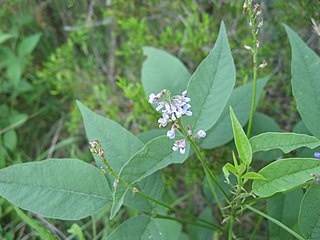
Bistorta officinalis, known as bistort, common bistort, European bistort or meadow bistort, is a species of flowering plant in the dock family Polygonaceae native to Europe and northern and western Asia. Other common names include snakeroot, snake-root, snakeweed and Easter-ledges.

Vicia cracca, is a species of vetch native to Europe and Asia. It occurs on other continents as an introduced species, including North America, where it is a common weed. It often occurs in disturbed habitats, including old fields and roadside ditches.

Lathyrus japonicus is a legume native to temperate coastal areas of Asia, Europe, and North and South America.

Baptisia australis, commonly known as blue wild indigo or blue false indigo, is a flowering plant in the family Fabaceae (legumes). It is native to much of central and eastern North America and is particularly common in the Midwest, but it has also been introduced well beyond its natural range. Naturally it can be found growing wild at the borders of woods, along streams or in open meadows. It often has difficulty seeding itself in its native areas due to parasitic weevils that enter the seed pods, making the number of viable seeds very low. The seeds may be toxic.

Packera obovata, the roundleaf ragwort or spoon-leaved ragwort, is an erect perennial herb native to Eastern North America. It was previously called Senecio obovatus. Basal and lower leaves are obovate with toothed margins, while upper leaves are pinnately divided. The ray flowers are yellow and the disk flowers orange-yellow, the inflorescences being held well above the foliage.

Oxytropis campestris, the field locoweed, is a plant native to the Northwestern United States and all Canada, sometimes grown as an ornamental plant.

Veronicastrum virginicum, or Culver's root, is a species of flowering plant in the plantain family, native to the eastern United States and south-eastern Canada. Growing to 200 cm (79 in) tall by 45 cm (18 in) broad, it is an erect herbaceous perennial with slender racemes of white or occasionally pink or purple flowers in summer.

Acalypha rhomboidea is a plant in the spurge family, Euphorbiaceae.

Salvia azurea, the azure blue sage, azure sage, blue sage or prairie sage, is a herbaceous perennial in the genus Salvia that is native to Central and Eastern North America.

Arnoglossum plantagineum also known as tuberous Indian-plantain, groovestem Indian plantain or Prairie Indian Plantain, is a North American species of Arnoglossum in the sunflower family. he Latin specific epithet plantagineum refers to the leaves of the plant which are similar to those of a plantain.

Dalibarda repens(dewdrop, false violet, star violet, Robin runaway. French Canadian: dalibarde rampante) is a perennial plant in the rose family, native to eastern and central Canada and to the northeastern and north-central United States. It is the only species in the genus Dalibarda, which is closely allied with the genus Rubus. The species is often included in the genus Rubus as Rubus repens (L.) Kuntze. It is fairly easily grown in shady locations in damp to wet, acidic soils, and is frequently used in wildflower and bog gardens as a ground-cover.

Zizia aurea is a flowering perennial forb of the carrot family (Apiaceae). Golden alexanders is native to eastern Canada and the United States, from the eastern Great Plains to the Atlantic Coast. Named for Johann Baptist Ziz. a German botanist.

Silphium integrifolium is a species of flowering plant in the aster family, Asteraceae. Its common names include rosinweed, whole-leaf rosinweed, entire-leaf rosinweed, and prairie rosinweed. It is native to eastern North America, including Ontario in Canada and the eastern and central United States as far west as New Mexico.

Amorpha canescens, known as leadplant, downy indigo bush, prairie shoestring, or buffalo bellows, is a small, perennial semi-shrub in the pea family (Fabaceae), native to North America. It has very small purple flowers with yellow stamens which are grouped in racemes. Depending on location, the flowers bloom from late June through mid-September. The compound leaves of this plant appear leaden due to their dense hairiness. The roots can grow up to 5 m (16 ft) deep and can spread up to 1 metre radially. This plant can be found growing in well-drained soils of prairies, bluffs, and open woodlands.

Stanleya pinnata is a species of flowering plant in the family Brassicaceae known as desert princesplume. It is native to North America.

Hydrophyllum capitatum, is a species of waterleaf known by the common name ballhead waterleaf. It is native to Western North America from British Columbia to Utah.

Hedysarum boreale is a species of flowering plant in the Fabaceae, or legume family, and is known by the common names Utah sweetvetch, boreal sweet-vetch, northern sweetvetch, and plains sweet-broom. It is native to North America, where it is widespread in northern and western regions of Canada and the United States. The ssp. mackenzii can even be found in the Canadian Arctic Archipelago.

Tetraneuris acaulis is a North American species of flowering plants in the sunflower family. Common names include angelita daisy, stemless four-nerve daisy, stemless hymenoxys, butte marigold, and stemless rubberweed.

Desmodium illinoense, the Illinois ticktrefoil, is a flowering plant in the bean family (Fabaceae), native to the central United States and Ontario, Canada. Illinois ticktrefoil grows in sunny places, such as prairies and oak savannas of the Great Plains and Great Lakes regions.

Orbexilum onobrychis, commonly called French-grass or lanceleaf scurfpea, is a species of flowering plant in the legume family (Fabaceae). It is native to the eastern United States where its range is concentrated in the Midwest and Upper South. Its natural habitat is primarily prairies and riverbanks, typically in mesic or wet areas. It is an uncommon species, and can be found in high-quality prairie remnants as well as more disturbed areas.





















